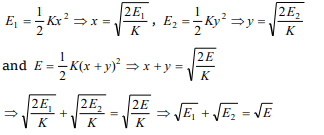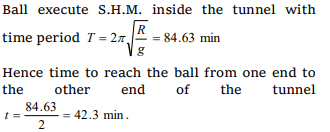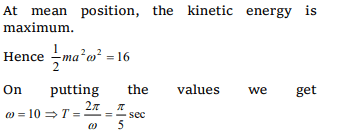1. A particle of mass m is hanging vertically by an
ideal spring of force constant K. If the mass is
made to oscillate vertically, its total energy is
a) Maximum at extreme position
b) Maximum at mean position
c) Minimum at mean position
d) Same at all position
Explanation: In simple harmonic motion, energy changes from kinetic to potential and potential to kinetic but the sum of two always remains constant.
2.A body is moving in a room with a velocity of 20
m / s perpendicular to the two walls separated by
5 meters. There is no friction and the collisions
with the walls are elastic. The motion of the body
is
a) Not periodic
b) Periodic but not simple harmonic
c) Periodic and simple harmonic
d) Periodic with variable time period
Explanation: Body collides elastically with walls of room. So, there will be no loss in its energy and it will remain colliding with walls of room, so it’s motion will be periodic. There is no change in energy of the body, hence there is no acceleration, so it’s motion is not SHM.
3. A body is executing Simple Harmonic Motion. At a
displacement x its potential energy is \[E_{1}\] and at a
displacement y its potential energy is \[E_{2}\] . The
potential energy E at displacement (x + y) is
a) \[\sqrt{E}=\sqrt{E_{1}}-\sqrt{E_{2}}\]
b) \[\sqrt{E}=\sqrt{E_{1}}+\sqrt{E_{2}}\]
c) \[E=E_{1}+E_{2}\]
d) \[E=E_{1}-E_{2}\]
Explanation:

4. A particle moves such that its acceleration a is
given by \[a=-bx\] , where x is the displacement
from equilibrium position and b is a constant. The
period of oscillation is
a) \[2\pi\sqrt{b}\]
b) \[\frac{2\pi}{\sqrt{b}}\]
c) \[\frac{2\pi}{b}\]
d) \[2\sqrt{\frac{\pi}{b}}\]
Explanation:

5. The equation of motion of a particle is \[\frac{d^{2}y}{dt^{2}}+ky=0\] where K is positive constant. The
time period of the motion is given by
a) \[\frac{2\pi}{k}\]
b) \[2\pi k\]
c) \[\frac{2\pi}{\sqrt{k}}\]
d) \[2\pi \sqrt{k}\]
Explanation:

6.A tunnel has been dug through the centre of the
earth and a ball is released in it. It will reach the
other end of the tunnel after
a) 84.6 minutes
b) 42.3 minutes
c) 1 day
d) Will not reach the other end
Explanation:

7.The maximum speed of a particle executing
S.H.M. is 1 m/s and its maximum acceleration is
1.57 m / \[sec^{2}\] . The time period of the particle will be
a) \[\frac{1}{1.57}sec\]
b) 1.57 sec
c) 2 sec
d) 4 sec
Explanation:

8. The motion of a particle executing S.H.M. is given
by \[x=0.01\sin 100\pi\left(t+0.5\right)\] , where x is in metres and
time is in seconds. The time period is
a) 0.01 sec
b) 0.02 sec
c) 0.1 sec
d) 0.2 sec
Explanation:

9. The kinetic energy of a particle executing S.H.M.
is 16 J when it is in its mean position. If the
amplitude of oscillations is 25 cm and the mass of the particle is 5.12 kg, the time period of its
oscillation is
a) \[\frac{\pi}{5}\] sec
b) \[2\pi\] sec
c) \[20\pi\] sec
d) \[5\pi\] sec
Explanation:

10. The acceleration of a particle performing S.H.M.
is 12 cm / \[sec^{2}\] at a distance of 3 cm from the mean
position. Its time period is
a) 0.5 sec
b) 1.0 sec
c) 2.0 sec
d) 3.14 sec
Explanation:
